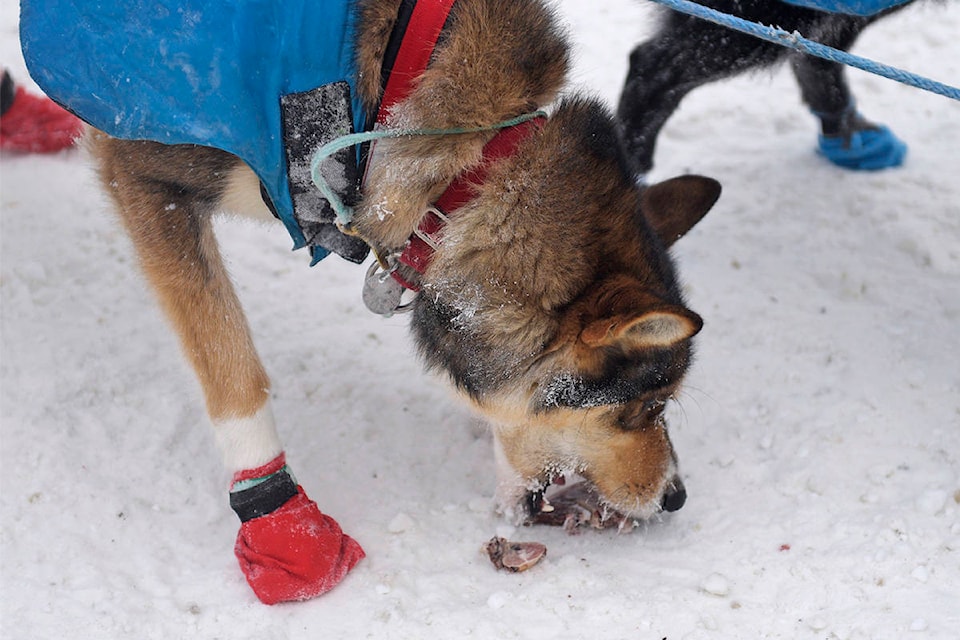While the 30 mushers who set out from Whitehorse on Feb. 2 in the 2019 Yukon Quest are extreme athletes in their own right, it’s hard to deny that the real stars of the show are the dogs.
The Quest rules dictate that a team must start the race with a minimum of eight dogs, can race with a maximum of 14 dogs, and must have at least six dogs in order to finish.
So with 14 dogs for every musher, it’s no wonder that more than a dozen professionals are dedicated to keeping the teams healthy and safe throughout the race.
Dr. Nina Hansen, the head veterinarian for the Yukon Quest, has been part of the Quest for 10 years and is in her fifth year as head veterinarian. She explained that 12 vets, one vet student, and two veterinary technicians make up this year’s team responsible for the dog examinations during the race.
“We do physical exams. We do exams before the race and then we do full physical exams at each of the four mandatory vet checks on the race,” said Hansen during an interview in Pelly Crossing on Feb. 4, adding that this year those stops are Braeburn and Dawson in the Yukon and Eagle and Two Rivers on the Alaskan side.
Additionally, all the other checkpoints and dog drops have vets stationed at them and mushers are required to have their vet book signed at non-mandatory checkpoints following brief exams.
Hansen said that the vet checks at the mandatory checks are similar to what a family pet would get.
“We do a full physical exam at those mandatories, just like if you took your pet to the vet,” said Hansen. “I like to start at the head and work my way back.”
Hansen said the exam includes assessing the dog’s hydration, checking the colour of the mucus membrane, listening to the dog’s heart and lungs, looking at the dog’s mouth, teeth, eyes and ears, palpating the dog’s abdomen, giving the dog a body condition score, and an orthopaedic exam.
The body condition score is a numeric scale from one to nine, where one is a very emaciated dog and nine is a very obese dog. Dogs that run the Quest are usually in the middle.
“We like for them to all be fours or fives,” said Hansen.
The orthopaedic exams assess the dogs’ limbs, putting each one through a range of motion and checking for any pain.
At the non-mandatory stops, the vet checks consist of a visual assessment, a body condition score, and a hydration assessment at a minimum.
Thanks to poor trail conditions between Braeburn and Carmacks and the subsequent rerouting of the race, mushers were able to add dogs up until Pelly Crossing, meaning the veterinary staff had some extra work to do.
“They’re allowed to add dogs in Pelly — this is the last point to add dogs — so we are scanning the microchips of the dogs that they’re adding to confirm that they’re the original dogs that we scanned at the start and examined at previous vet checks,” said Hansen.
In the event a dog can’t continue running while out on the trail, mushers are required to transport the dog to the next checkpoint or dog drop in the safety and comfort of the sled.
Per the Quest rules, a dog can enter a checkpoint in the sled basket and rejoin the team on the line to depart provided it is healthy enough to do so. Mushers are also required to carry eight pairs of booties for each dog, including any the dog is wearing, when leaving a checkpoint.
But before dogs get anywhere near the trail, there are some additional criteria they need to meet.
Dogs need to be vaccinated against parvovirus, distemper, leptospirosis, bordetella, and rabies, with very specific deadlines for each vaccine.
The dogs who run the Yukon Quest, like the mushers, are truly a special breed.
The Yukon Quest 2019 rules state that “only dogs suitable for Arctic travel will be permitted to enter the race,” meaning a team of greyhounds or chihuahuas is categorically out.
With that in mind, it’s no wonder that the race is almost exclusively run by Alaskan huskies, Siberian huskies, and Malamutes.
“(The dogs) have thick hair coats — most of them have double hair coats,” said Hansen. “Then they consume an insane amount of calories, and that’s what keeps them running and keeps them warm.”
When temperatures dip down to the -35 to -50 C range, Hansen said they eat even more.
“They do eat extra calories when it is cold,” said Hansen. “It’s warming up … but it was -50 F (-45 C) on Sunday morning in Carmacks so it was very, very cold. We watch their weights pretty carefully when it’s cold.”
Contact John Hopkins-Hill at john.hopkinshill@yukon-news.com
